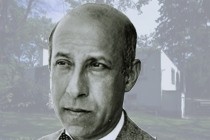Presentation
Josef Frank and the housing today
Book presentation and discussion

Josef Frank and the housing today
© Erwin Reichmann
Although the architect Josef Frank is one of the most remarkable representatives of the Austrian modern architecture, until nowadays his work has been appreciated by a comparatively small circle.
Built works of Josef Frank before the First World War – most of them in cooperation with Oskar Strnad and Oskar Wlach – had already an advanced position within modern architecture.
Book presentation
Short lecture by Maria Welzig on her book:
JOSEF FRANK 1885 -1967
The architectural work
Discussion
In 1934, before his emigration to Sweden, Frank gave students private lessons free of charge. The young Roland Rainer was among his listeners. He links up to the table discussion with a short speech on:
Josef Frank and the housing today
The completely different positions of the participants promise a lively discussion on the situation of housing today. The initial point is Josef Frank¹s sharp criticism of the Viennese housing practice as well as the initiatives he set like the model estate of the Austrian Werkbund created between 1929 and 1932 and his cooperation in the Vienna settle-movement.
Roland Rainer – Hermann Czech – Helmut Richter – Johannes Spalt – Gerhard Steixner
Moderation: Dietmar Steiner
The book
Josef Frank 1885-1967
The architectural work
(In German only)
Publisher: Böhlau – Verlag, 1998
310 pages
40 colour illustr.
270 black-and-white illustr.
Autor: Maria Welzig
ISBN 3-205-98471-4
Although the architect Josef Frank is one of the most remarkable representatives of the Austrian modern architecture, until nowadays his work has been appreciated by a comparatively small circle.
Built works of Josef Frank before the First World War – most of them in cooperation with Oskar Strnad and Oskar Wlach – had already an advanced position within modern architecture. For the first time the architect`s student years, his work in Bruno M`öhring`s studio in Berlin (1908/09) and his early furnishings are going to be closer analysed in the presented volume. Frank`s student work for an exhibition hall in Vienna (1907) represents a discovery.
The author, the art historian Maria Welzig (thesis on the work of the architect Josef Frank until 1938), shows the modern architecture of the twenties as being an unhomogeneous movement, in which Frank`s criticism on rigid, dogmatic Functionalism represents a constitutive – and by no means singular- element. The relations between the Viennese architect and leading international representatives of the Modern Movement is being treated in a subtly differentiated way.
As shown in the volume, the Eastasian culture as well as the American way of life and living gave Frank`s work an essential impetus. The projects of the thirties – often ignored – illustrate a search for additional spatial achievements.
The late architectural work after the Second World War develops this process up to a design concept based on a principle of accidentism. Frank looks for a way to intentionally create a traditional disorder in contrast to the coldness and rigidity of Functionalism and to achieve a viable modern architecture making the world more human, homely and habitable.
Frank however did not have the opportunity to realize his late ideas, he was last commissioned in 1936. His late work has to be seen against the background of his personal situation in the emigration, marked by isolation and resignation.
For the first time the present book enables to have a comprehensive knowledge of the architect and his work.
Biography / Worklist
1895
Josef Frank is born in Baden near Vienna
1903-1908
studies at the Technical University in Vienna
1914
co-founder of the Austrian Werkbund
1919-1925
teacher at the Vienna School of Arts and Crafts
1925
founder of the “house and garden” company, together with Oskar Wlach
1927
participation at the planning of the Weissenhof housing estate in Stuttgart
1928
co-founder of CIAM
1930-1932
chief planner of the Werkbund housing estate in Vienna
1933
emigration to sweden
1934-1966
work for the Svenskt Tenn furnishing house, Stockholm
1941-1946
exile in New York, late graphical and theoretical work
1946
return to sweden
1967
Josef Frank dies on January 8 in Stockholm
Important Buildings
1914
houses at the Wilbrandtgasse ,Vienna
1924
housing development Wiedenhoferhof , Vienna
1927
house Beer, Vienna
1929-1930
Semi-detached house in the Weissenhof housing estate, Stuttgart
1936
house Wehtje, Falsterbo
blueprints for furniture, items of furniture, fabrics, wallpapers, carpets.
Links
A humane and comfortable modernism
Article on Josef Frank, by Christopher Long (English)
Two buildings
Further information on the Viennese Werkbundsiedlung and the Villa Beer in Vienna (German)
Brunschwig & Fils
A short information on Josef Frank`s textile designs (English)
Josef Frank, Architect and Designer
Another book on Josef Frank, by Nina Stritzler-Levine (English)
